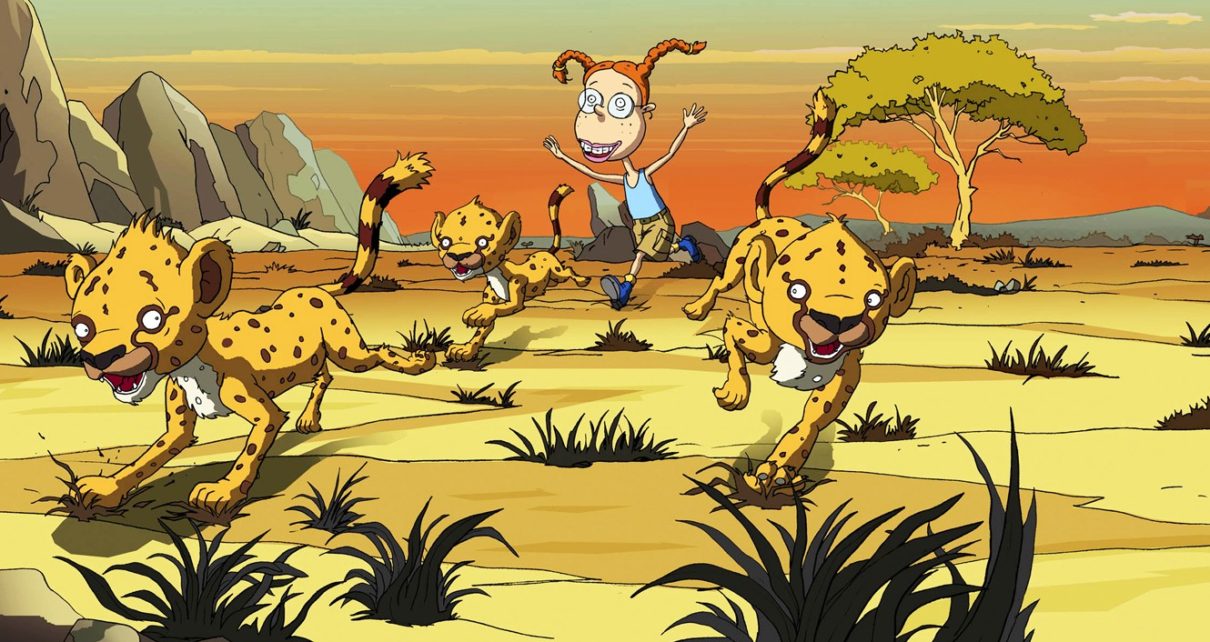This story is a part of Nicktoons Month!
Any kids worth their weight in Pokémon cards and Crazy Bones know that the ’90s were a time of skyrocketing environmental interest and girl power. Al Gore leveraged his position as Vice-President to create more initiatives and educate the public about climate change and greenhouse gases. Conservationists found an audience to help spread the word about the rainforest and its inhabitants. Plus, we had the Spice Girls. So it should come as no surprise that the Michael Jordans of the Nicktoons lineup, Arlene Klasky and Gabor Csupo of the Klasky Csupo production company, would create a show embodying the dual spirit of the moment: The Wild Thornberrys.
Following the adventures of Eliza Thornberry, a spunky pre-teen gifted with the ability to talk to animals, the show ran from 1998 to 2004 and spawned two movies, one of which crossed over with Rugrats. Other characters on the show included her documentary-making mother and father, Marianne and Nigel; her angst-ridden, grunge-fueled, teenage sister, Debbie; the feral boy they adopted, Donnie; and her snarky sidekick chimpanzee, Darwin.
Traveling the world and filming a documentary TV show from their ever-adaptable mobile home, the Commvee, the Thornberrys traveled to 39 different countries during the show’s run, dealing with environmental concerns ranging from oil spills to deforestation to endangered species. The show was rife with eco-conversation pieces — which translated to “award-winning darling.” Thornberrys won the Genesis Award twice, Best Tele-Feature Animation at the Burbank International Children’s Film Festival in 2001 for “The Origin of Donnie,” and an Environmental Media Award for “You Otter Know.”

While The Wild Thornberrys may be best recognized as the show that taught millennials from a young age to recycle, keep our minds open to different cultures, and give a damn about this small blue-and-green dot we call home, its environmental lessons could sometimes feel a little heavy-handed. Look to “You Otter Know” (Sn. 2 Ep. 20) and Eliza’s final line about the oil spill, “It scares me, Darwin — all the sea otters could’ve died,” and you’ll be able to feel the bamboo shoots of pedantic moralization prying up your fingernails. Granted, they were trying to educate eight-year-olds.
But The Wild Thornberrys did more than just teach eco-friendly lessons. It also empowered girls to live life like Eliza Thornberry.
A cross between Jane Goodall and Anne of Green Gables, Eliza dealt with emergency scenarios featuring everything from poisonous toxins to avalanches to wildfires. In each instance, she would fly into the fray and, with her quick scientific wit and deductive reasoning, figure out the best method to rescue those she cared about. Her actions speak volumes — but more importantly, she never tried to be anything more than herself. She was content with her braces and glasses, freckles and red hair. She didn’t care if she got messy out in the wild, unlike her older sister Debbie. She just wanted to immerse herself in the world around her.
Eliza’s empathy is why she was granted powers in the first place, as shown in the flashback episode “Gift of Gab” (Sn. 2 Ep. 29). By helping a shaman while he was trapped in the body of a warthog, Eliza was able to break the curse—and as thanks, the shaman granted her the ability to talk to animals. Unlike the Disney trope of “you’re pretty, therefore I will give you things,” Eliza’s powers are the direct result of her most deeply-rooted character trait: her compassion for others.
The universe of The Wild Thornberrys also makes a poignant statement in the way Eliza’s abilities — and capabilities — are typically challenged. Rather than have an episode’s antagonists put her down because she’s a girl and girls “can’t do those things,” her haters challenge her age and upbringing.
In “A Shaky Foundation” (Sn. 2 Ep. 33), the foundation head’s son, Tom, patronizes Eliza because of her age. Only after he gets the Commvee stuck in a raging river and Eliza ends up saving the day does he appreciate her quick thinking. The same goes for Eliza’s rivalry with her cousin in “Tyler Tucker, I Presume” (Sn. 3 Ep. 4). Instead of joking about Eliza’s sex, Tyler needles her for her lack of knowledge of the outside world, and for being a know-it-all when it comes to animals.
The Wild Thornberrys took a powerful stance on what women are capable of. By having no one question Marianne, Debbie, or Eliza on their abilities just because of their sex, Klasky Csupo enforces the idea that women can — and should — do anything.
While some may say that’s a naïve or unrealistic portrayal of being a woman in the real world, I kindly disagree. The Wild Thornberrys was always about making our world a better place to live. That may have initially meant environmentally, but it could also apply to how women are viewed. Eliza showed us all we need is a little compassion to truly understand each other.
Thanks for reading The Dot and Line, where we talk about animation of all kinds. Don’t forget to ❤ this article and follow us on Twitter and Facebook.





